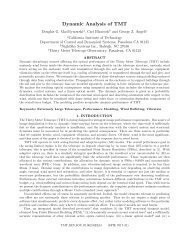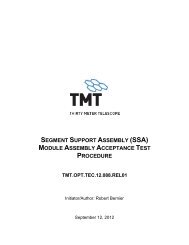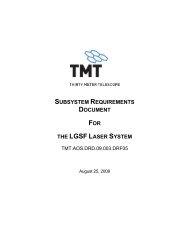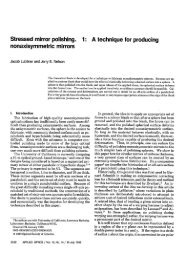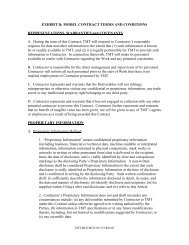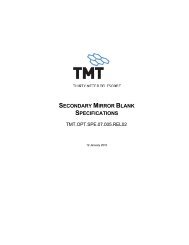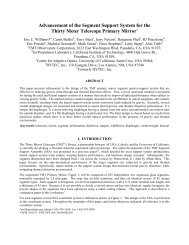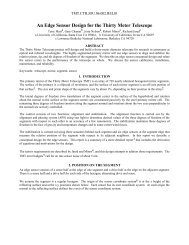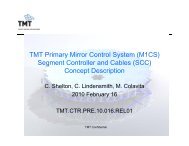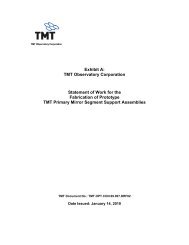TMT Construction Proposal - Thirty Meter Telescope
TMT Construction Proposal - Thirty Meter Telescope
TMT Construction Proposal - Thirty Meter Telescope
Create successful ePaper yourself
Turn your PDF publications into a flip-book with our unique Google optimized e-Paper software.
nearby galaxies. In the nearest dwarf galaxies, such as the Magellanic clouds, it will be possible to probe the<br />
initial mass function to much lower masses, all the way down to the brown dwarf regime.<br />
2.8.2 Physical conditions in star-forming regions<br />
In star-forming regions we see infalling gas, which produces new stars. We also see outflows of material<br />
expelled by newly-forming stars. The competition between infall and outfall provides a feedback mechanism<br />
that regulates the star formation rate and the masses of the stars. The details of these processes are not yet<br />
understood. However, they are accessible to observation with next-generation telescopes. Infrared radiation<br />
allows us to penetrate these dust-enshrouded regions, and the large aperture of <strong>TMT</strong> will provide<br />
unprecedented spatial resolution with adaptive optics. The multiplexing capability of IRMOS will allow many<br />
outflows to be resolved, and their interaction with the interstellar medium to be studied. These studies will be<br />
complementary to studies using ALMA, which will provide information about the composition and densities of<br />
the molecular clouds.<br />
Fig 2-15: Images of young stellar objects (left). Dusty disks can be seen obscuring the<br />
star, and bipolar outflows occur along the symmetry axis. The right panel shows the<br />
number of sources as a function of infrared flux. The two vertical lines represent the<br />
detection limits of 10-m telescopes (red) and <strong>TMT</strong> (blue). <strong>TMT</strong> will be able to detect and<br />
study virtually all YSOs in nearby star forming regions (<strong>TMT</strong> MIRES team).<br />
Fig 2-16: Artist’s impression of a protoplanetary disk, showing a planet orbiting within the<br />
ring that it has cleared (left). Profile of an emission line from a hypothetical spectroscopic<br />
observation (right). The double peak arises from the Doppler shift due to the rotation of<br />
the disk particles). By analyzing the spectrum, it is possible to detect the gap and thus<br />
infer the presence of the planet (G. Bryden & J. Najita, NOAO).<br />
<strong>TMT</strong> <strong>Construction</strong> <strong>Proposal</strong> 14



